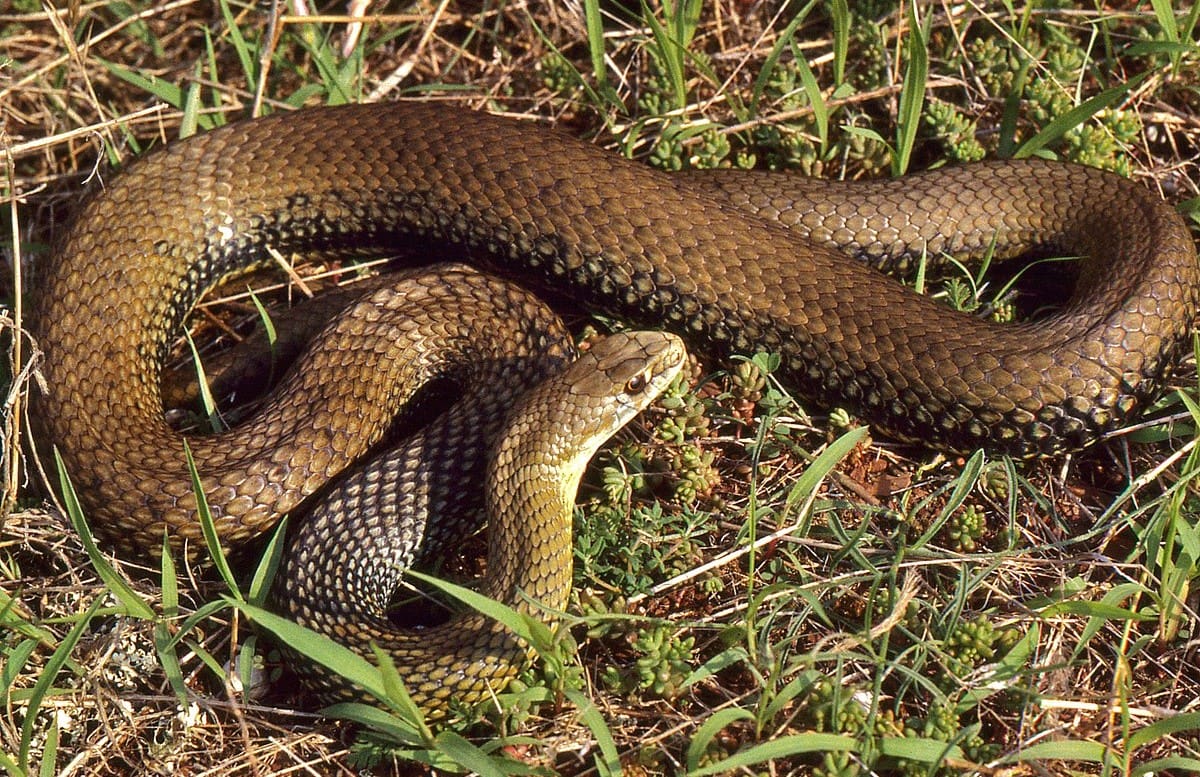
The Montpellier snake, also known as Malpolon monspessulanus, is a fascinating and often misunderstood species. With its distinctive appearance and intriguing behavior, this snake has captured the curiosity of both nature enthusiasts and herpetologists. Found in the Mediterranean region, including parts of Europe, North Africa, and the Middle East, the Montpellier snake is known for its impressive length and agility.
In this article, we will delve into 18 surprising facts about the Montpellier snake that will not only intrigue you but also broaden your understanding of this remarkable creature. From its unique hunting techniques to its diverse diet, there’s so much about the Montpellier snake that is worth exploring. So, let’s dive into the intriguing world of this snake species and discover some truly amazing facts!
Key Takeaways:
- Montpellier Snakes are non-venomous, agile hunters with a diverse diet, playing a crucial role in ecosystem balance by maintaining the population of their prey species.
- These impressive climbers have a long lifespan, can make hissing sounds when threatened, and are mostly active during the day, making them easier to spot in their natural habitat.
It is one of the largest snakes in Europe.
The Montpellier Snake can grow up to an impressive length of 2.5 meters, making it one of the largest snake species found in Europe.
Its name comes from the city of Montpellier, France.
The snake is named after Montpellier, a city in the south of France, where it can be commonly found in its natural habitat.
The Montpellier Snake is known for its impressive speed.
Unlike other slow-moving snake species, the Montpellier Snake is incredibly swift and agile, allowing it to swiftly capture its prey.
This snake is non-venomous.
Contrary to popular belief, the Montpellier Snake is not venomous. It relies on its strong jaws and constricting abilities to subdue and consume its prey.
It has a varied diet.
The Montpellier Snake has a diverse diet, mainly consisting of lizards, small mammals, birds, and even other snakes. It is a skilled hunter that adapts to various food sources.
Montpellier Snakes are excellent climbers.
These snakes are proficient climbers and can be frequently spotted in trees, using their muscular body and prehensile tail to navigate and hunt in elevated areas.
Their coloration varies.
The Montpellier Snake exhibits a wide range of color variations, including shades of green, brown, and even gray. This ability helps them blend seamlessly into their surroundings.
They have an elongated body shape.
With a slender and elongated body, the Montpellier Snake has a distinct physique that enables it to move swiftly through various terrains, including grasslands and shrublands.
Montpellier Snakes are mostly diurnal.
Unlike many other snake species, the Montpellier Snake is primarily active during the day, making it easier to spot in its natural habitat.
They are not aggressive towards humans.
Montpellier Snakes are generally docile and prefer to retreat rather than engage in confrontation when encountering humans. They pose little threat to humans unless provoked.
The mating ritual is intricate.
During the mating season, male Montpellier Snakes engage in an elaborate courtship display to attract females, involving impressive body movements and intertwining.
Montpellier Snakes lay eggs.
As oviparous reptiles, female Montpellier Snakes lay eggs rather than giving birth to live young. They bury their eggs in warm soil to facilitate proper incubation.
Their offspring are independent from birth.
Once hatched, Montpellier Snake hatchlings are fully independent and capable of hunting and fending for themselves right from the start.
They can make hissing sounds.
When threatened or feeling cornered, Montpellier Snakes emit a loud hissing sound as a warning signal, often accompanied by an open-mouthed display to intimidate predators.
Montpellier Snakes have a long lifespan.
These snakes have a relatively long lifespan and can live up to 15 years or more when their habitat conditions are favorable and their food sources are abundant.
They have specialized teeth for swallowing prey.
Montpellier Snakes possess rearward-pointing teeth, which aid in gripping and swallowing their prey whole, allowing for efficient consumption of larger prey items.
Their natural habitat is diverse.
Montpellier Snakes can be found across a range of habitats, including dry and rocky areas, forests, and even coastal regions. This adaptability contributes to their survival.
They play a crucial role in ecosystem balance.
As predators, Montpellier Snakes play an essential role in maintaining the population of their prey species, thus contributing to a balanced ecosystem.
These were just a few of the surprising facts about the Montpellier Snake. As a unique and fascinating reptile, it continues to captivate researchers and nature enthusiasts alike with its intriguing behaviors and characteristics.
Conclusion
In conclusion, the Montpellier Snake is an amazing and fascinating creature with many surprising facts. From its venomous nature to its unique defense mechanisms, this snake has evolved to survive in various environments. Its ability to climb trees and swim adds to its versatility as a predator. Despite popular misconceptions, the Montpellier Snake is not aggressive towards humans and prefers to avoid confrontation.By understanding these facts about the Montpellier Snake, we can appreciate the intricacies of the natural world and the diverse range of animal species that inhabit it. The more we learn about these incredible creatures, the better equipped we are to coexist with them and preserve their natural habitats.
FAQs
Q: Are Montpellier Snakes dangerous?
A: While Montpellier Snakes are venomous, they are not considered a significant threat to humans. Their venom is primarily used for subduing their prey, and they rarely bite unless provoked.
Q: What do Montpellier Snakes eat?
A: Montpellier Snakes are carnivorous and primarily feed on small mammals, lizards, and birds. They are known for their ability to swallow prey whole due to their expandable jaws.
Q: Where do Montpellier Snakes live?
A: Montpellier Snakes are native to the Mediterranean region, particularly in countries like France, Spain, and Italy. They are adaptable and can be found in various habitats, including grasslands, forests, and rocky areas.
Q: How long can Montpellier Snakes grow?
A: Montpellier Snakes are moderately sized, with adults reaching an average length of 3 to 5 feet. However, some individuals have been recorded to grow up to 8 feet in length.
Q: Do Montpellier Snakes make good pets?
A: Montpellier Snakes are not recommended as pets. They have specific care needs and require a proper understanding of their natural behavior. Additionally, some countries have regulations regarding the ownership of venomous snakes.
Montpellier snakes are fascinating creatures, but they're not the only intriguing reptiles out there. False cobras, often mistaken for Malpolon monspessulanus, have their own set of surprising characteristics. Reptiles boast a diverse array of species with countless amazing adaptations and behaviors. Some of the most awe-inspiring members of this group are venomous snakes, which have evolved potent toxins for defense and prey capture. Dive into the world of these incredible animals and uncover more astonishing facts that will leave you amazed by the wonders of the natural world.
Was this page helpful?
Our commitment to delivering trustworthy and engaging content is at the heart of what we do. Each fact on our site is contributed by real users like you, bringing a wealth of diverse insights and information. To ensure the highest standards of accuracy and reliability, our dedicated editors meticulously review each submission. This process guarantees that the facts we share are not only fascinating but also credible. Trust in our commitment to quality and authenticity as you explore and learn with us.


